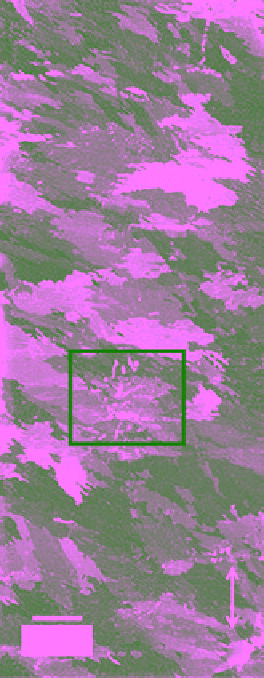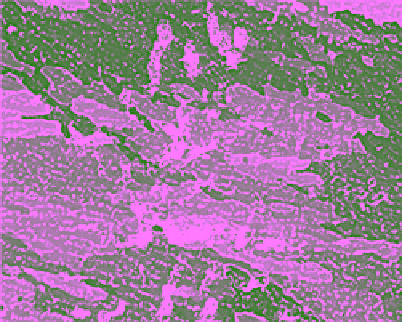Geology Reference
In-Depth Information
(a)
(b)
20 mm
Figure 4.28
Photograph of a double‐microtomed 100 mm × 270 mm horizontal thin section of (a) young sea ice of
S3 type at depth of 0.25 m, made in a field laboratory in Mould Bay (76°14'N, 119°20' W). The arrow indicates
approximate direction of water current. The area delineated by the rectangle in (a) around a refrozen brine channel
is shown in (b) (photograph of N. K. Sinha, unpublished).
waters.
Gow et al.
[1982] reported up to 50% frazil ice dur-
ing their 1980 cruise, while
Clarke and Ackley
[1982] found
a predominance of frazil (70%) during their 1981 cruise.
These observations were essentially sporadic and made
on opportunity basis without any knowledge of the his-
tory of the formation of the ice cover. As mentioned ear-
lier the Mould Bay experiment provided opportunities
for understanding many aspects of sea ice, including the
physical and structural arrangement of oriented frazil ice
(now classified as S5 type). Tests on this type of ice were
conducted in a field at laboratory in Mould Bay as well
as under precisely controlled laboratory conditions at
NRC in Ottawa [
Sinha,
1986]. At that time there was no
information on the microstructural details or the strain‐
rate‐sensitive strength and deformation of young congealed
ice available in the open literature. Thus, the Mould Bay
studies filled a gap of information.
Structural details of the S5‐type frazil ice are illustrated
in Figure 4.29. Vertical and horizontal thin sections were
made from a large block (through the full depth of the
cover) of young frazil ice extracted on 25 October 1981.
On that date, the ice sheet was 42 cm thick and hence by
definition qualified to be FY. In general, the grains in the
frazil layer were small and elongated as seen in the vertical
section. The long axis of the grains tended to be at right
angles to the ice surface. The length of the grain is between
2 and 5 mm and the diameter is about 0.5-1.5 mm. The tex-
ture of this layer, therefore, was transversely isotropic with
the plane of isotropy parallel to the surface. This texture in
the ice sheet was developed as a result of closer packing
when the elongated frazil crystals formed in the water
of the fjord were driven by wind toward the eastern shore.
As mentioned earlier, records at the weather office in
Mould Bay indicated heavy wind from the west before 24
September 1981, the freeze‐up date for Mould Bay. A sim-
ilar type of ice texture (now classified as S5 type) has also
been noted by
Sinha
[unpublished] in a MY floe in north
Baffin Bay near Ellesmere Island. Ice with discoid stacked
in a vertical position (
c
axis horizontal) has also been
reported by
Weeks and Ackley
[1982].


